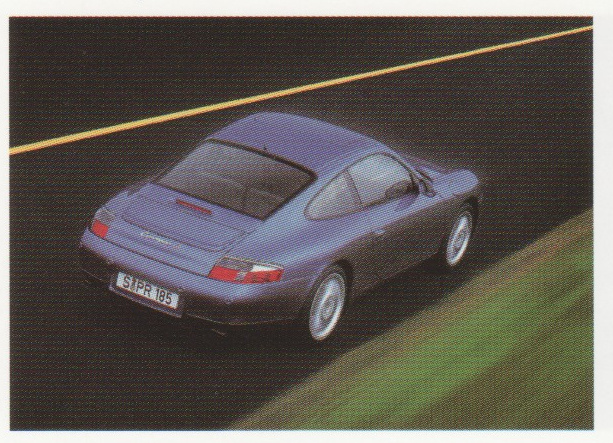
2000 Carrera 4
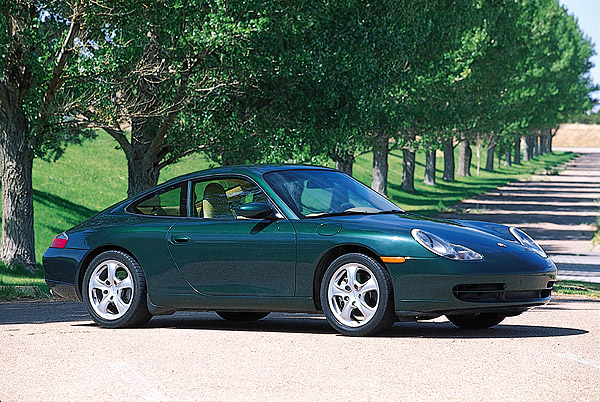
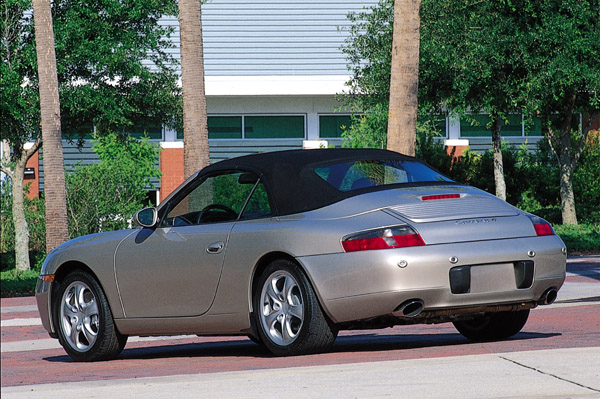
ATLANTA – Porsche originated the all-wheel drive supercar with the first Porsche® 911™ Carrera® 4 more than 10 years ago, and the new-generation model, introduced in 1999, continues to set standards for sportscar handling and stability. The automaker’s passion for continuous improvement focused on improved comfort and convenience for 2001, resulting in several standard enhancements and new options.
“Porsche pioneered the all-wheel drive sportscar, and we’re still way ahead of the competition in this area,” said Frederick J. Schwab, president and CEO of Porsche Cars North America. “All-wheel drive and the standard Porsche Stability Management system give the 911 Carrera 4 unparalleled command of a twisty road or a track event.”
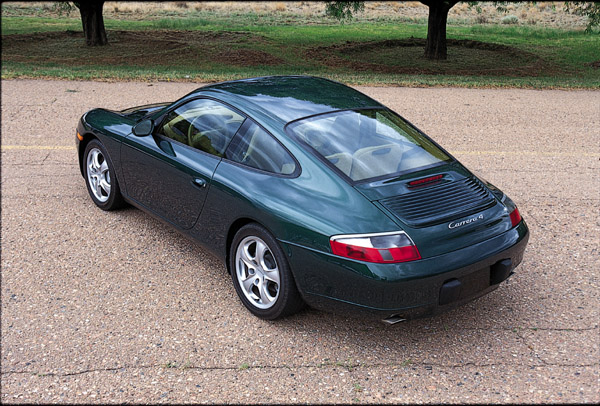
Porsche continues to refine the driving environment in the 911 Carrera 4. On top of the significant interior enhancements it received in model-year 2000, the 911 Carrera 4 features upgraded trunk carpet quality and additional functions for the standard remote entry system. All Porsche models for 2001 feature new light-emitting diode (LED) interior orientation lights. One LED provides gentle illumination of the cockpit and center console. An LED on the driver’s side door handle illuminates the ignition lock and light switch, and an LED illuminates each door latch.
For 2001, Porsche has grouped some popular options into packages. For example, auto-dimming inside and outside rear-view mirrors have been combined with rain-sensing windshield wipers for one package. An additional standard interior c o l o r, Nephrite Green, was previously a special-order color. New available metallic exterior colors include Orient Red, Lapis Blue, Zanzibar Red, Seal Grey, and Meridian. Cinnamon Brown is a new special-order interior color.
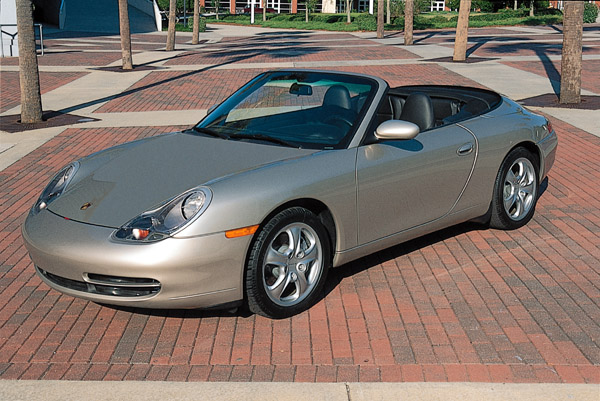
The 911 Carrera 4 is available as either a Coupe or Cabriolet model. In the 911 Carrera 4 Coupe, the rear seatbacks fold down to create a flat cargo floor. The fully automatic power soft-top on the Cabriolet folds compactly into a compartment behind the rear seats. A solid tonneau cover fits flush against the body with the roof lowered, preserving the sleek, uncluttered appearance.
Based on the 911 Carrera, the 911 Carrera 4 differs most in that its drivetrain powers all four wheels. Subtle exterior differences that distinguish the 911 Carrera 4 models from their rear-wheel drive siblings include a different wheel design than the standard 911 Carrera, as well as plainly visible titanium-color brake calipers. The rear engine hood carries a titanium-color “Carrera 4” logotype.
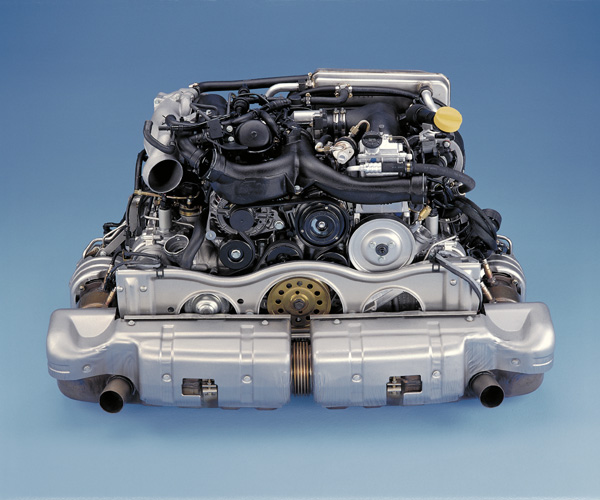
The 3.4-liter six-cylinder boxer engine in the 911 Carrera 4 produces 300 horsepower @ 6,800 rpm. A dual-stage resonance air intake system boosts power and torque at midrange engine speeds. With 258 lb.-ft. of peak torque at 4,600 rpm and at least 220 lb.-ft. available between 2,700 rpm-7,000 rpm, the 911 Carrera 4 can accelerate from rest to 62 miles per hour (0-100 km/h) in just 5.2 seconds.
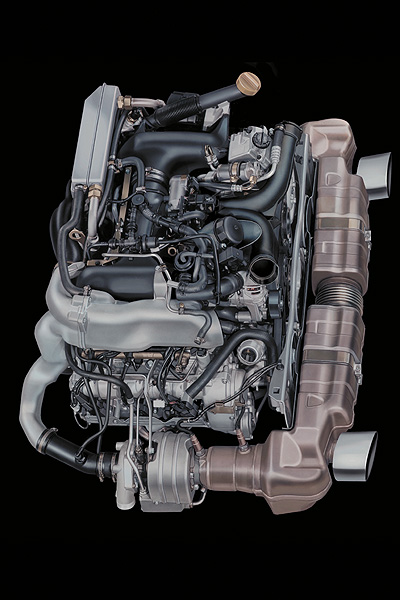
An aluminum cylinder block and heads make the engine light. Patented LOKASIL high-silicon cylinder liners help reduce friction and wear to such a level that Porsche can recommend a 15,000-mile (24,000 km) oil change interval and a 30,000-mile (48,000 km) oil filter change interval. The Porsche-patented VarioCam® system helps boost low-end and mid-range torque by varying valve timing between 1,250-5,120 rpm.
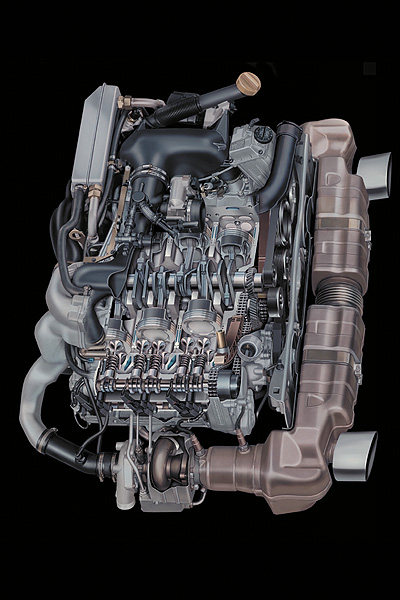
Sequential multi-port fuel injection features separate fuel mixture control for each cylinder bank, and a coil-on-plug (“distributorless”) ignition system provides quick response and reliable operation. The ME 7.2 engine control module incorporates the E-Gas electronic throttle. In place of a traditional throttle cable setup, E-Gas electronically transmits pedal position to the engine control unit. This system provides even sharper throttle response and ensures low emissions.
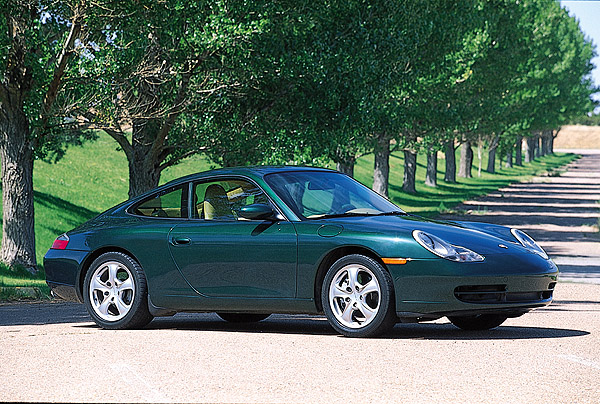
As in the previous 911 Carrera 4, the new-generation model uses an all-wheel drive system based on a viscous multi-plate clutch. The previous system located the viscous unit in the rear transaxle, which added weight to the rear. In the current 911 Carrera 4, Porsche located the viscous unit directly behind the front differential, which simplifies assembly and maintenance and moved some weight to the front. The front location allows Porsche to offer the optional Tiptronic S transmission in the 911 Carrera 4, because both the 911 Carrera and 911 Carrera 4 use the same transaxle.
Adding just 120 pounds (54 kg) to the standard 911 Carrera, the all-wheel drive system in the 911 Carrera 4 qualifies as one of the lightest such systems in the world. Accommodating the front diff e rential and halfshafts for the 911 Carrera 4 model required minor modifications to the strut mounting position, as well as a reshaped fuel tank.
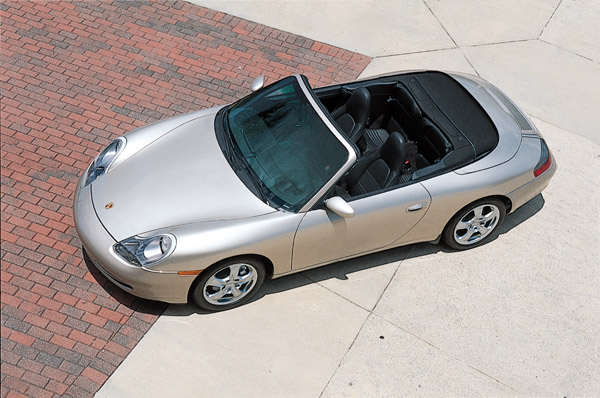
The all-wheel drive system directs torque to the front wheels at a rate of five-to-40 percent, depending on available traction and power applied. The viscous unit compensates for differing wheel speeds during cornering. The 911 Carrera 4 exhibits outstanding traction on all road surfaces. However, Porsche designed the system to offer superior handling on mainly dry road surfaces. The automaker did not intend the all-wheel drive system as an all-weather traction assistant.
Porsche equips the 911 Carrera 4 with the advanced Porsche Stability Management system (PSM) as standard equipment. Porsche added PSM to the 911 Carrera option list for 2000, and for 2001 it’s available as an option on the Boxster and Boxster S models.
Using data from several sensor inputs, PSM can detect a loss of grip at the front or rear and reduce instability by applying braking to individual wheels and, if necessary, altering engine power. On slippery roads, PSM can help keep the 911 Carrera 4 going in the direction the driver steers.
The PSM system operates so quickly that most drivers likely will not feel it make corrections. The driver can disengage PSM with a dashboard switch. However, for safety, PSM will engage under braking and then disengage when the driver lifts off the brake. While confident in the system’s ability as a dynamic handling aid, Porsche cautions drivers that PSM cannot counteract the laws of physics.
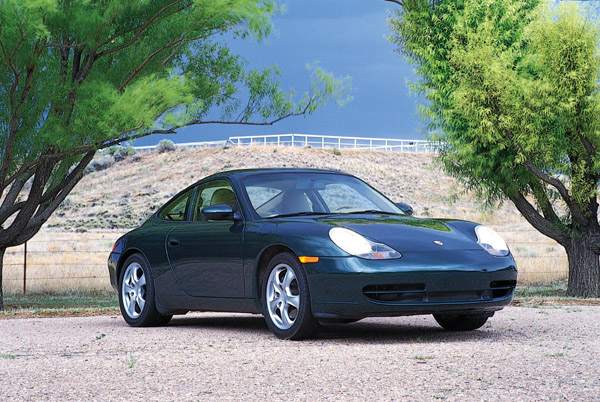
Porsche optimized the new-generation 911 Carrera platform for both the rear-wheel drive model and the all-wheel drive 911 Carrera 4. The two models therefore share powertrains, suspension, and steering systems. Four-wheel independent suspension features a Porsche-optimized MacPherson-strut design in front and a multilink setup in the rear, both with aluminum suspension components to reduce unsprung weight. Front and rear stabilizer bars and gas-charged shock absorbers provide flatter cornering. Standard power rack-and pinion steering yields a quick 2.98 turns lock-to-lock and a tight 34.8-ft. (10.6-meter) turning circle.
A “staggered” wheel/tire array (wider wheels and wider, lower-profile tires on the rear) contributes to more neutral handling in the 911 Carrera 4. The standard aluminum alloy wheels measure 17 x 7 inches in front and mount 205/50 ZR17 tires; the 17 x 9-inch rear wheels mount 255/40 ZR17 tires. An optional 18-inch wheel/tire package enhances the already sharp handling and offers a choice of different wheel designs.
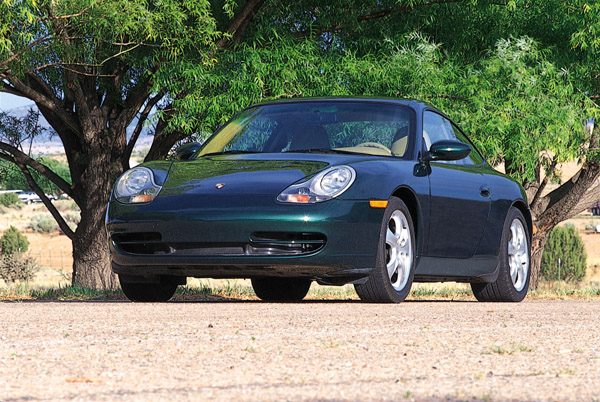
The 911 Carrera 4 stops with four-wheel vented disc brakes with ABS 5.3 anti-lock control. Derived from the Porsche GT1 racecar, one-piece brake calipers reduce unsprung weight and heat. The front discs measure 12.5 inches in diameter and 1.1-inch thick (318 mm x 28 mm). The rear discs measure nearly as large – 11.8 inches in diameter and 0.95-inch thick (299 mm x 24 mm). The cross-drilled rotors dissipate heat to maintain braking performance and brake feel even under hard usage. (Porsche requires brakes to provide 25 consecutive full-force stops without fade.)
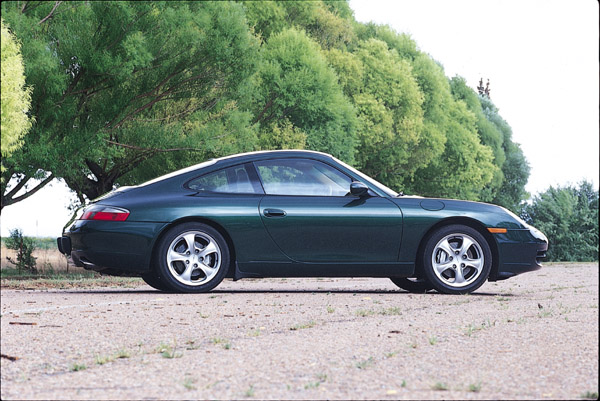
The 911 Carrera 4 offers a choice between a precisely-shifting standard six-speed manual and the optional Tiptronic® S five-speed automatic transmission. The six-speed manual features a dual-mass flywheel for low vibration and a hydraulic clutch for consistent performance.
With the advanced Tiptronic S, the driver can place the shift lever into “D” and let the transmission do the shifting, or shift into “M” and control gearshifts with steering wheel-mounted thumb switches. In automatic mode, Tiptronic S uses one of five programmed shift “maps” to respond to the driving style. For example, during leisurely driving, Tiptronic S will upshift early to provide a quiet ride and the best fuel efficiency. Quicker stabs at the gas pedal will call up a sporty shift program, which holds each gear longer for crisp response and power.
Even while in automatic mode, the computer-controlled Tiptronic S responds like a driver working a manual transmission, downshifting or holding lower gears when cornering and driving on hills. Tiptronic S also allows the driver to select manual mode by pressing an up- or downshift button, even with the shift lever in the “D” position.
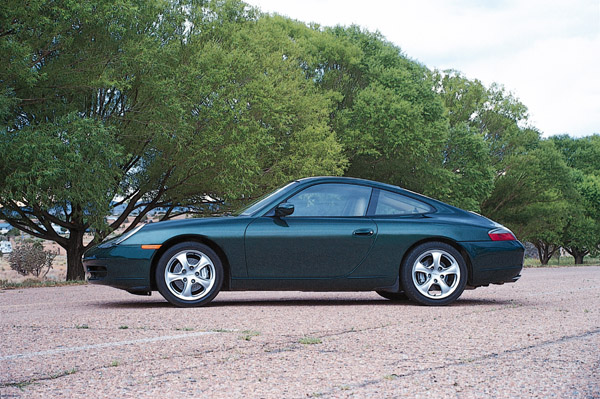
With the high performance potential of the 911 Carrera 4 comes a high level of occupant protection. A patented crumple zone body structure protects a reinforced passenger compartment. All new Porsche models include dual front airbags plus the Porsche Side Impact Protection System that includes boron-steel door reinforcement beams, energy-absorbing door panels, and door-mounted side airbags. The 30-liter capacity sidebags provide protection for the chest, head, and pelvis.
In the 911 Carrera 4 Cabriolet, the boron-steel reinforced A-pillars and windshield header combine with an automatic-deploying supplemental rollover structure to reduce the risk of injury in the event of a rollover accident. The optional Park Assist feature audibly warns drivers of obstacles behind the car.
Reflecting its evolution into a grand touring sportscar, the 911 Carrera 4 comes with many standard luxury features:
Notable options include the Porsche Communication Management system, which integrates controls and displays for Global Positioning Satellite (GPS) navigation, onboard computer, and climate control. A five-inch (diagonal) LCD color screen displays all functions. Litronic high-intensity gas-discharge headlights, available in option packages, increase lighting range and improve edge and side lighting for safer cornering.
Every new model-year 2001 Porsche car sold in the United States and Canada is covered by a four-year/50,000-mile (80,000 kilometer), bumper-to-bumper limited warranty, which includes Porsche’s roadside assistance program. The galvanized body and 26-step paint and anti-corrosion process enable Porsche to warrant each car against rust perforation for 10 years and unlimited mileage. In addition, Porsche guarantees the paint finish for three years – also without a mileage limitation.
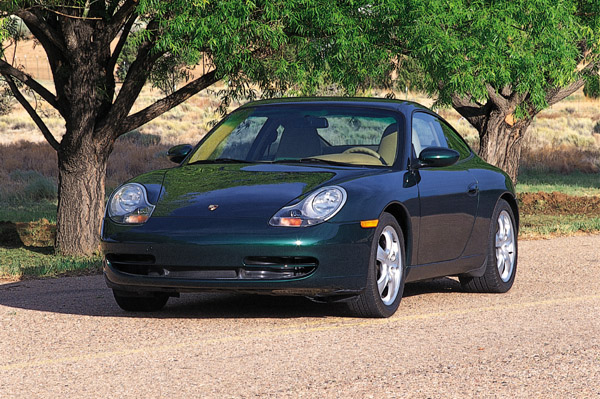
Porsche pioneered the all-wheel drive sportscar, introducing the first Carrera® 4 in 1989 and the new-generation Porsche® 911™ Carrera 4 in 1999. The 911 Carrera 4 – along with the 2001 all-wheel drive 911 Turbo – delivers the highest level of driving dynamics the company has ever offered in a road car for North America. The all-wheel drive system uses a viscous multi-plate clutch mounted just behind the front differential. The system directs torque to the front wheels at a rate of five-to-40 percent, depending on available traction and the power applied. Porsche Stability Management (PSM) provides the ultimate level of control by correcting for loss of grip at either the front or rear tires. Porsche designed the all-wheel drive system to offer superior handling on mainly dry road surfaces. The automaker did not intend the all-wheel drive system as an all-weather traction assistant. Safety technology includes a patented crumple-zone body structure, dual front airbags, door-mounted side airbags, and anti-lock brakes. The 911 Carrera 4 – in both coupe and Cabriolet models – feature s a different wheel design than the standard 911 Carrera, as well as plainly visible titanium-color brake calipers. The rear engine hood carries a titanium-color “Carrera 4” logotype. The Cabriolet model features a fully automatic power roof, an automatic deploying supplemental safety bar structure, and a standard removable aluminum hardtop.
Porsche has added several convenience features to the 911 Carrera 4 models. Interior orientation lights use light-emitting diodes (LEDs) to provide gentle illumination of the cockpit and center console, ignition lock and light switch, and door latches. The remote entry system adds enhanced functions, and the trunk features improved carpeting. Some popular options have been grouped into packages. An additional standard interior color, Nephrite Green, was previously a special-order color. New available exterior metallic colors include Orient Red, Lapis Blue, Zanzibar Red, Seal Grey, and Meridian.
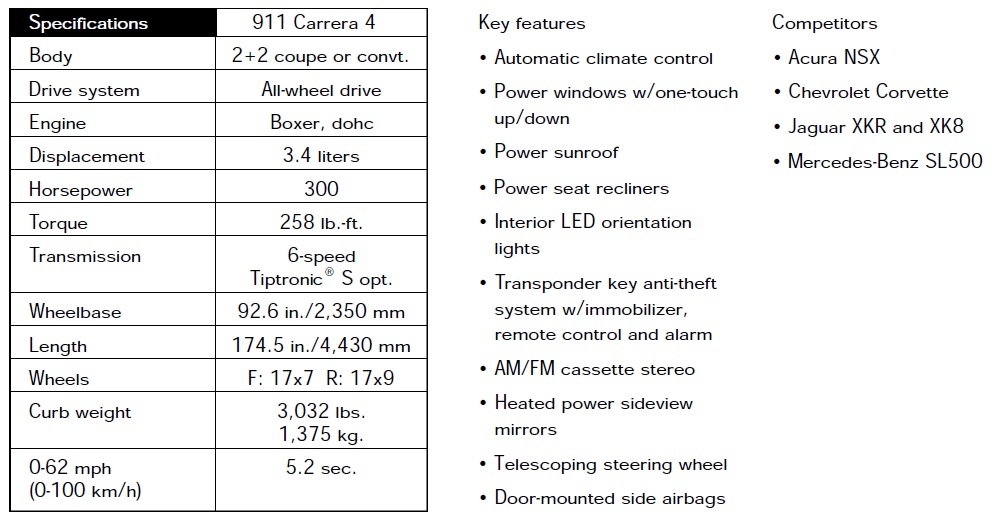
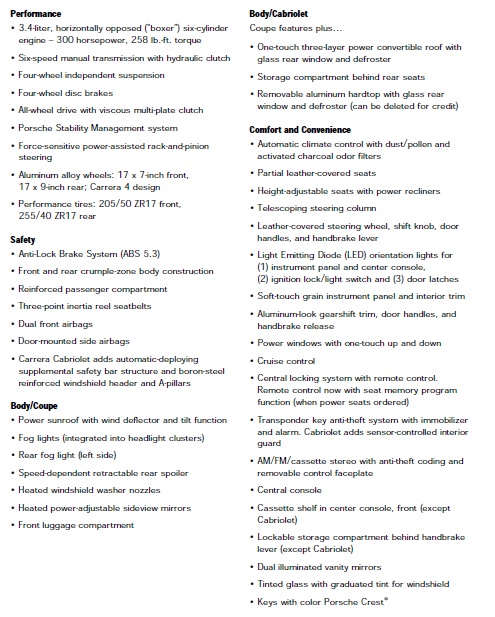
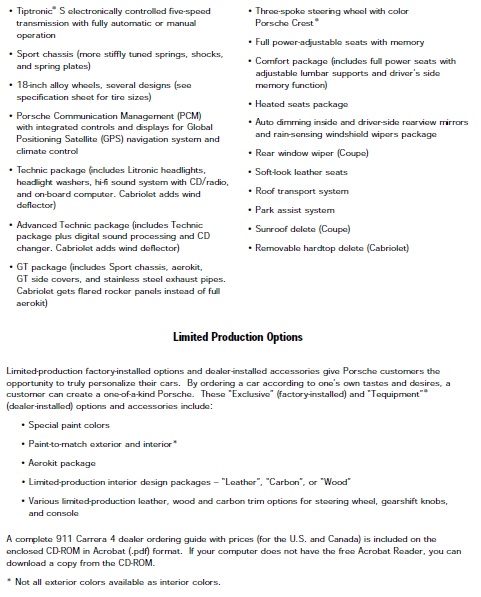
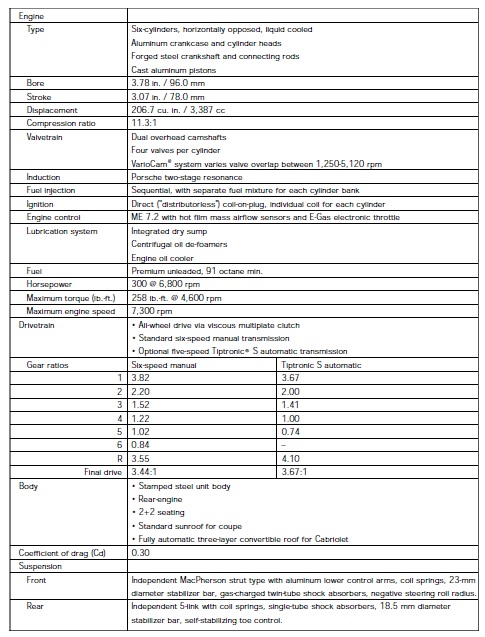

2000 Carrera 4

2002 Carrera 4 (under construction)

Porsche Press kit

Porsche Literature

Our Porsche Cars